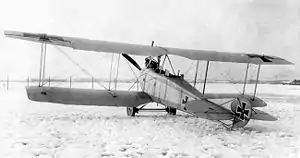| C.I | |
|---|---|
 | |
| Aviatik C.I trainer (late series) | |
| Role | Reconnaissance aircraft |
| Manufacturer | Aviatik |
| First flight | 1915 |
| Introduction | 1915 |
| Retired | 1917 |
The Aviatik C.I was an observation aircraft which came into service during World War I in April 1915. It was a development of the Aviatik B.I and B.II models, being one of first aircraft of the new German C class of armed biplanes. In the C.I the observer sat in front of the pilot, with a machine-gun clipped on a sliding mounting fitted on a rail at either side of the cockpit.[1] It gave the crew the means to attack enemy aircraft.[2] The positions of the pilot and observer were reversed in last series of 50, ordered in 1917 solely for trainer purpose.[3] There was only one aircraft built of refined C.Ia version in May 1916, with armament still in a forward cab, serving as a prototype for C.III.[3] Later models of the plane included the Aviatik C.II and the C.III, which had more powerful engines. The C.III was produced in large numbers.
548 Aviatik C.I were built in total: 402 by Aviatik (including 51 trainers and 1 C.Ia) and 146 by Hannover.[4]
Variants
- C.I
- Primary model
- C.I(Han)
- Primary model licence-built by Hannover, initially designated Hannover C.I
- C.I trainer
- Last series of 50 plus a prototype manufactured in 1917, with a machine gun in rear cab.[3]
- C.Ia
- Prototype for C.III, flown in May–June 1916.[3]
- C.II
- This model was powered by a 149 kW (200 hp) Benz Bz.IV engine. it was not produced in quantity.[5]
- C.III
- The C.III was a 1916 refinement which was operated until 1917.[5]
Operators
- Royal Yugoslav Air Force - Postwar
Specifications
Data from German Aircraft of the First World War [6]
General characteristics
- Crew: 2
- Length: 7.925 m (26 ft 0 in)
- Wingspan: 12.5 m (41 ft 0 in)
- Height: 2.95 m (9 ft 8 in)
- Wing area: 43 m2 (460 sq ft)
- Empty weight: 750 kg (1,653 lb)
- Gross weight: 1,340 kg (2,954 lb)
- Powerplant: 1 × Mercedes D.III 6-cylinder water-cooled in-line piston engine, 119 kW (160 hp)
- Propellers: 2-bladed fixed-pitch propeller
Performance
- Maximum speed: 142 km/h (88 mph, 77 kn)
- Endurance: 3 hours
- Service ceiling: 3,500 m (11,500 ft)
- Time to altitude: 1,000 m (3,300 ft) in 12 minutes
- Wing loading: 31.2 kg/m2 (6.4 lb/sq ft)
- Power/mass: 0.089 kW/kg (0.054 hp/lb)
Armament
- Guns: 1x Parabellum MG14 mounted on cockpit side rails
Notes
- ↑ Gray, Thetford (1970), p. 59-63
- ↑ van Wyngarden, G. Early German Aces, p.6
- 1 2 3 4 Grosz, Peter M. Aviatik C.I. Berkhamsted: Albatros Productions, 1997, Windsock Datafile no.63. ISBN 0-948414-95-2. p.5-6
- ↑ Grosz, Peter M. Aviatik C.I. Berkhamsted: Albatros Productions, 1997, Windsock Datafile no.63. ISBN 0-948414-95-2. p.5-6, 32
- 1 2 Janes, p.88
- ↑ Thetford 1962, pp.59–63.
References
- Gray, Peter & Thetford, Owen (1987) [1970]. German Aircraft of the First World War (2nd ed.). London: Putnam. ISBN 0-85177-809-7.
- Herris, Jack (2023). Aviatik Aircraft of WWI: A Centennial Perspective on Great War Airplanes. Great War Aviation Centennial Series. Vol. 10 (2nd ed.). n.p.: Aeronaut Books. ISBN 978-1-953201-59-1.
- Klaauw, Bart van der (March–April 1999). "Unexpected Windfalls: Accidentally or Deliberately, More than 100 Aircraft 'arrived' in Dutch Territory During the Great War". Air Enthusiast (80): 54–59. ISSN 0143-5450.
- van Wyngarden, G. Early German Aces of World War 1. Oxford: Osprey Publishing, 2006. ISBN 1-84176-997-5
- Taylor, Michael J H. Jane's Encyclopedia of Aviation. Portland House, 1989. ISBN 0-517-69186-8